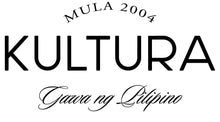The Evolution of Filipiniana


(Left) Baro’t Saya in the late 1800s, also known as Maria Clara; (Right) Kultura’s Modern Filipiniana Collection: Nuevo Ystilo Women's Inabel Ethnic Top and Raffaella Mikado Bias Skirt in Blue
Filipiniana serves as a glorious symbol of our unique identity and culture. While it adapts to the changing times, it stays rooted in its Filipino values of modesty, practicality, and resilience.
Evolution through Diverse Cultural Influences
Today’s colorful and vibrant Filipino culture has been influenced by other cultures over the past centuries. Some of which have seamlessly integrated with the Philippines’ earliest traditions. Looking back, the 333-year Spanish colonial period (1565-1898) remains the most significant cultural influence on Filipino fashion, cuisine, and religious beliefs.
Key Elements of the Filipiniana Ensemble
The National Commission for Culture and the Arts (NCCA) breaks down the key elements of what makes a Filipiniana a Filipiniana. The ensemble is made up of the camisa or baro (top), the kamison or corpiño (chemise), the pañuelo or alampay (scarf), the manggas (sleeves), the saya (skirt), the inaguas or naguas (cotton slip underneath the skirt), and the tapis or sobre falda (over skirt).
Accessories add the final touch to the traditional dress, consisting mainly of footwear called sapatilla or cocho (flats/short-heeled slippers); a panyo or pañuelito (handkerchief) carried by hand or tied to the waist area; earrings and kwintas (necklace); an abanico (fan); and a payneta (small headpiece).
Learn how this dress captured the unchanging confidence and grace of the Filipina throughout generations. Here’s how the traditional Filipiniana evolved from the 1800s to modern times.
Baro’t Saya

Fabián de la Rosa’s 19th-century painting, “Filipina”
The baro’t saya was the earliest form of Filipiniana. Brought by the Spaniards in the 1800s for Christianized Filipino women to wear, it’s an aptly named traditional dress made up of the baro and the saya.
Modesty was imperative during this era, hence the required use of an alampay or pañuelo for additional coverage on the chest area. The tapis was generally used to cover the bottom half of the 2-piece dress.
Maria Clara (1890s)

Maria Clara in the 1890s
Named after the famous heroine in Dr. Jose Rizal’s “Noli Me Tangere,” the Maria Clara dress symbolized the interwoven cultures of Spain and the Philippines. Quite similar to the baro’t saya, it consists of four garments: the baro and saya with the addition of a tapis and pañuelo.
What makes it different from the previous version is its more elegant silhouette, exaggerated puffed sleeves and intricate embroidery.
TRAJE DE MESTIZA (1910)

Traje De Mestiza in 1910
In 1910, at the turn of the century, a new silhouette was introduced called the Traje De Mestiza or mestiza dress. Compared to the loose baro, the blouse or camisa was transformed into a shapely bodice that accentuated the waist. The bell-shaped sleeves were flattened against the shoulders and eventually became known as butterfly sleeves. During this time, the fabrics and patterns of both the tops and bottoms started to match as well, hence the term “Terno.” The current designs you see today originated from the Traje De Mestiza.
Balintawak (1930s)

Balintawak of the 1930s
The Traje de Mestiza was worn on more formal occasions. Following the changes in the lifestyle of Filipinas in the 1930s, the Balintawak was created. It was used as a casual alternative to the formal mestiza dress.
Made with a shorter skirt and butterfly sleeves, it allowed ease of movement and was a more comfortable option for the hot and humid weather in the Philippines. The dress was aptly worn for outdoor activities and events, such as picnics and strolling.
Terno of the Modern Times

Filipiniana has indeed gone through countless iterations, with transformations coming in the form of fitted silhouettes, weaves, and textiles used- from piña to shantung silk, cocoon silk, and jusi- to decorative details shifting from embroidery to hand-painting and beadwork.


Current fashion designers of modern Filipino culture clothing use their craft to evoke and spread the Philippines’ one-of-a-kind cultural identity. With their consistent effort, it’s expected that Filipiniana will continuously evolve, blending functionality and individual expression to match the diversity of today’s global Filipina.
Support our local artists and artisans; wear your culture with pride!
References:
- Kultura 101: “Ternong Terno” by the National Commission on Culture and the Arts (https://www.facebook.com/NCCAOfficial/videos/5843761958983076/)
- https://philippinefolklifemuseum.org/portfolio_category/evolution-of-philippine-costume/

